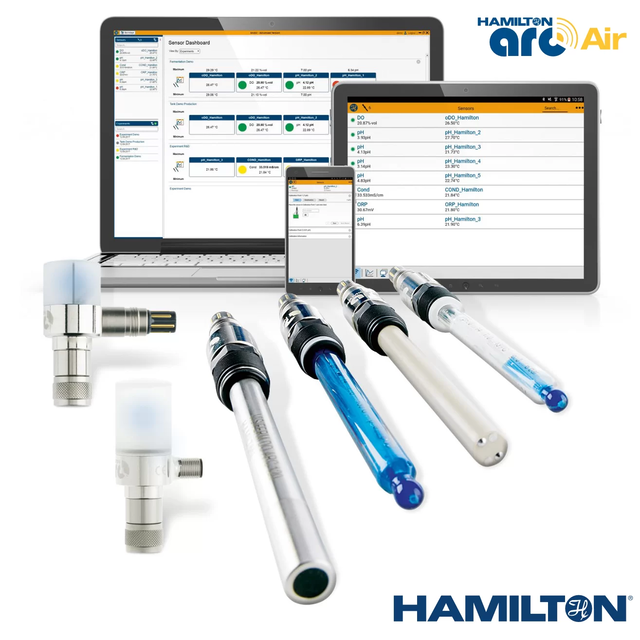Hamilton ARC intelligent sensors
The Applikon Livit Flex, ez2-Control, my-Control, in-Control and SUB-Control One support full integration of the Hamilton ARC sensor technology. The only thing needed to get access to the full ARC sensor technology information is the activation of the Hamilton ARC driver in your Applikon control system.
HAMILTON ARC eases the integration of sensors by rethinking communication between sensors, end users and process control systems. The functionality of a traditional transmitter has been replaced by a microprocessor within the sensor. ARC sensors bypass the transmitter and communicate directly to the Applikon process control system. Sensors are available in all standard pH, dissolved oxygen and conductivity formats.
The transmitter of the ARC sensors is built into the sensor. The specific sensor data stay with the sensor at all times.
Arc sensors include a robust connection directly to the Applikon process control system. This allows easy configuration, calibration, and troubleshooting of Arc sensors though the Applikon controller software using the familiar Applikon controller human interface.
Features der Hamilton ARC Sensoren
- Intelligent sensors
An integrated microprocessor eliminates the need for an external transmitter. The following sensor output options are available: nA, 4 - 20 mA and digital protocols. - Sensor caps
Depending on the application, different types of sensor caps are available - Bluetooth Sensor Management
VisiFerm mA / VisiTrace mA have integrated Bluetooth and VisiFerm RS485 requires the optional Arc Wi adapter. All sensors are compatible with the ArcAir software.
Visiferm Optische DO Sensoren
Optical sensors measure using an oxygen-sensitive fluorescent dye. The dye requires no equilibration time so it is instantly ready for use. A quality indicator displays the health of the sensor cap, and maintenance is as simple as removing and reinstalling the cap.

Benefits of going with Optical Dissolved Oxygen
Optical dissolved oxygen sensors offer a significant improvement over traditional amperometric sensors commonly used in the demanding applications found in pharmaceutical, biotechnology, and beverage applications. Process related drift due to carbon dioxide and other acid gases is fully eliminated with optical technology. Maintenance and calibration intervals can also be extended as optical sensors do not require electrolyte or internal cathode/anode replacement. Finally, optical sensors have no polarization time thus can accurately measure oxygen immediately upon power up.
- Insensitive to CO2 fouling
- Eliminates polarization
- Simplifies maintenance with a single replacement part
- No electrolyte to contaminate the process
- Quicker response time
- Measurement is independent of flow
- Stable against pressure spikes
- Can be installed inverted
- Insensitive to poisoners like H2S and Ammonia

How does optical dissolved oxygen work?
The sensing element for an optical DO sensor is an oxygen sensitive luminophore. A blue light from the sensor excites the luminophore. When the excited molecule returns to its ground state it gives off red light. In the presence of oxygen some of the energy is transferred to the oxygen molecule. The oxygen measurement is made by comparing the excitation light (blue) to the emitted light (red).
Easyferm pH Plus Sensor

pH (hydrogen ion concentration) is a critical measurement and control parameters for many liquid processes. Hamilton Process Analytics offers a wide selection of pH probe and ORP probe solutions for use in all bioprocesses.
EasyFerm Plus Arc pH sensors combine the accuracy and longevity of pre-pressurized reference technology with Arc Intelligence. Arc sensors offer industry standard 4 - 20mA and Modbus RTU output signals directly from the sensor for connection to the Process Control System. Arc technology complies with the the needs of the pharmaceutical industry with the ability to autoclave, SIP, or CIP clean the sensor.
Incyte Arc Sensor
Incyte Arc sensors provide a means for directly measuring viable cell density in real-time. Please find here more information. Densytee Arc Sensor Total cell density measurement by the Dencytee sensor is based on the optical density, the turbidity of a suspension at NIR wavelengths. Please find here more information.

Facts and Figures
Applications
- Cell culture and fermentations
- Batch, FedBatch, Continuous and Perfusion
- Pharma, Food, Cellular Agriculture, mABs, Cell and Genetherapy, Therapeutics, Vaccines
Bioreactors
- Glass Autoclavables
- Single-Use AppliFlex ST (via DO ODO Cap as Single-Use Sensor)
- Stainless-Steel
Category:
Applications:
Process development, Research Optimization, Pilot Plant, Manufacturing, Fundamental, Screening
Cultivation Volumes:
< 100ml, < 1L, < 10L, < 100L, > 100L
Types:
We are eager to receive your feedback
* Mandatory fields
